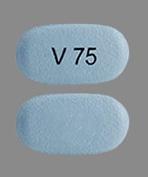Symdeko and Alcohol/Food Interactions
There are 3 alcohol/food/lifestyle interactions with Symdeko (ivacaftor / tezacaftor).
Ivacaftor Food/Lifestyle
Moderate Food Interaction
Consumer information for this interaction is not currently available.
GENERALLY AVOID: Grapefruit juice may increase the plasma concentrations of ivacaftor. The proposed mechanism is inhibition of CYP450 3A4-mediated first-pass metabolism in the gut wall by certain compounds present in grapefruit. Elexacaftor and tezacaftor are also CYP450 3A4 substrates in vitro and may interact similarly with grapefruit juice, whereas lumacaftor is not expected to interact.
ADJUST DOSING INTERVAL: According to prescribing information, systemic exposure to ivacaftor increased approximately 2.5- to 4-fold, systemic exposure to elexacaftor increased approximately 1.9- to 2.5-fold, and systemic exposure to lumacaftor increased approximately 2-fold following administration with fat-containing foods relative to administration in a fasting state. Tezacaftor exposure is not significantly affected by administration of fat-containing foods.
MANAGEMENT: Patients treated with ivacaftor-containing medications should avoid consumption of grapefruit juice and any food that contains grapefruit or Seville oranges. All ivacaftor-containing medications should be administered with fat-containing foods such as eggs, avocados, nuts, meat, butter, peanut butter, cheese pizza, and whole-milk dairy products. A typical cystic fibrosis diet will satisfy this requirement.
Tezacaftor Food/Lifestyle
Moderate Food Interaction
Consumer information for this interaction is not currently available.
GENERALLY AVOID: Grapefruit juice may increase the plasma concentrations of tezacaftor, deutivacaftor, and vanzacaftor. The proposed mechanism is inhibition of CYP450 3A4-mediated first-pass metabolism in the gut wall by certain compounds present in grapefruit. In general, the effect of grapefruit juice is concentration-, dose- and preparation- dependent, and can vary widely among brands. Certain preparations of grapefruit juice (e.g., high dose, double strength) have sometimes demonstrated potent inhibition of CYP450 3A4, while other preparations (e.g., low dose, single strength) have typically demonstrated moderate inhibition. The risk and/or severity of serious side effects such as liver damage may be increased.
ADJUST DOSING INTERVAL: Administration with fat-containing food may increase the oral bioavailability of vanzacaftor and deutivacaftor. Administration with a fat containing meal increased vanzacaftor systemic exposure (AUC) by 4- (low-fat meal) to 6- (high-fat meal) fold. While deutivacaftor AUC increased approximately 3- (low-fat meal) to 4- (high-fat meal) fold, relative to administration in a fasting state. Tezacaftor exposure is not significantly affected by administration of fat-containing foods.
MANAGEMENT: Patients treated with tezacaftor, deutivacaftor, vanzacaftor -containing medications should avoid consumption of grapefruit juice and any food that contains grapefruit. To improve absorption, patients should be advised to take vanzacaftor and/or deutivacaftor containing medications with fat-containing foods such as eggs, avocados, nuts, meat, butter, peanut butter, cheese pizza, and whole-milk dairy products at approximately the same time of the day. A typical cystic fibrosis diet will satisfy this requirement.
Switch to professional interaction data
Ivacaftor High Blood Pressure (Hypertension)
Moderate Potential Hazard, Moderate plausibility
ivacaftor - hypertension
The use of products containing ivacaftor is associated with an increase in blood pressure. Close monitoring of blood pressure is recommended periodically in all patients, in particular in hypertensive patients.
Switch to professional interaction data
Symdeko drug interactions
There are 475 drug interactions with Symdeko (ivacaftor / tezacaftor).
Symdeko disease interactions
There are 8 disease interactions with Symdeko (ivacaftor / tezacaftor) which include:
- hepatic impairment
- renal impairment
- cataracts
- hepatic impairment
- hypertension
- organ transplant
- pulmonary impairment
- renal impairment
More about Symdeko (ivacaftor / tezacaftor)
- Symdeko consumer information
- Check interactions
- Compare alternatives
- Pricing & coupons
- Drug images
- Side effects
- Dosage information
- During pregnancy
- FDA approval history
- Drug class: CFTR combinations
- En español
Related treatment guides
Drug Interaction Classification
| Highly clinically significant. Avoid combinations; the risk of the interaction outweighs the benefit. | |
| Moderately clinically significant. Usually avoid combinations; use it only under special circumstances. | |
| Minimally clinically significant. Minimize risk; assess risk and consider an alternative drug, take steps to circumvent the interaction risk and/or institute a monitoring plan. | |
| No interaction information available. |
See also:
Further information
Always consult your healthcare provider to ensure the information displayed on this page applies to your personal circumstances.


